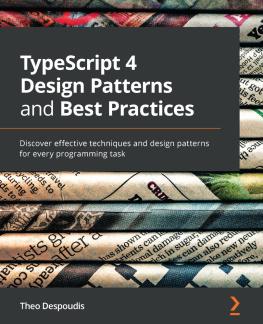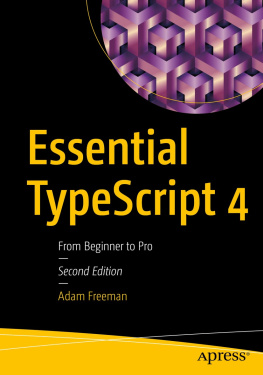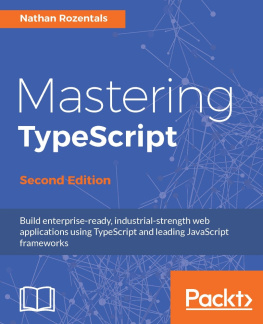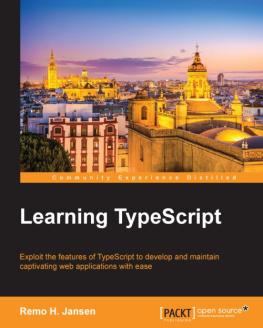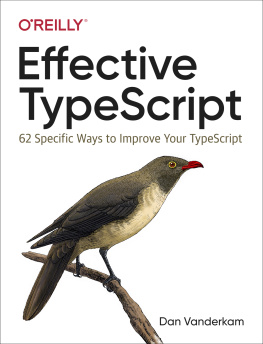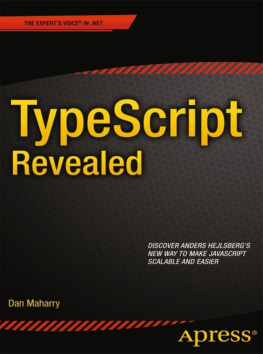Vilic Vane - TypeScript Design Patterns
Here you can read online Vilic Vane - TypeScript Design Patterns full text of the book (entire story) in english for free. Download pdf and epub, get meaning, cover and reviews about this ebook. year: 2016, publisher: Packt Publishing, genre: Computer. Description of the work, (preface) as well as reviews are available. Best literature library LitArk.com created for fans of good reading and offers a wide selection of genres:
Romance novel
Science fiction
Adventure
Detective
Science
History
Home and family
Prose
Art
Politics
Computer
Non-fiction
Religion
Business
Children
Humor
Choose a favorite category and find really read worthwhile books. Enjoy immersion in the world of imagination, feel the emotions of the characters or learn something new for yourself, make an fascinating discovery.
- Book:TypeScript Design Patterns
- Author:
- Publisher:Packt Publishing
- Genre:
- Year:2016
- Rating:3 / 5
- Favourites:Add to favourites
- Your mark:
- 60
- 1
- 2
- 3
- 4
- 5
TypeScript Design Patterns: summary, description and annotation
We offer to read an annotation, description, summary or preface (depends on what the author of the book "TypeScript Design Patterns" wrote himself). If you haven't found the necessary information about the book — write in the comments, we will try to find it.
TypeScript Design Patterns — read online for free the complete book (whole text) full work
Below is the text of the book, divided by pages. System saving the place of the last page read, allows you to conveniently read the book "TypeScript Design Patterns" online for free, without having to search again every time where you left off. Put a bookmark, and you can go to the page where you finished reading at any time.
Font size:
Interval:
Bookmark:
Copyright 2016 Packt Publishing
All rights reserved. No part of this book may be reproduced, stored in a retrieval system, or transmitted in any form or by any means, without the prior written permission of the publisher, except in the case of brief quotations embedded in critical articles or reviews.
Every effort has been made in the preparation of this book to ensure the accuracy of the information presented. However, the information contained in this book is sold without warranty, either express or implied. Neither the author, nor Packt Publishing, and its dealers and distributors will be held liable for any damages caused or alleged to be caused directly or indirectly by this book.
Packt Publishing has endeavored to provide trademark information about all of the companies and products mentioned in this book by the appropriate use of capitals. However, Packt Publishing cannot guarantee the accuracy of this information.
First published: August 2016
Production reference: 1240816
Published by Packt Publishing Ltd.
Livery Place
35 Livery Street
Birmingham
B3 2PB, UK.
ISBN 978-1-78528-083-2
www.packtpub.com
Author Vilic Vane | Copy Editor Safis Editing |
Reviewer Wander Wang | Project Coordinator Suzanne Coutinho |
Commissioning Editor Kunal Parikh | Proofreader Safis Editing |
AcquisitionEditor Denim Pinto | Indexer Rekha Nair |
Content Development Editor Nikhil Borkar | Graphics Jason Monteiro |
TechnicalEditor Hussain Kanchwala | Production Coordinator Aparna Bhagat |
Vilic Vane is a JavaScript engineer with over 8 years of experience in web development. He started following the TypeScript project since it went public, and hes also a contributor of the project.He is now working at Ruff, a startup company building an IoT platform that runs JavaScript on embedded devices.
I want to thank the editors and reviewers, including Wander Wang, for their efforts that made this book possible. I also want to thank my girlfriend, Emi, for not pissing me off when she came for me from her school 1,400 km away but could only have a takeout with me in my apartment due to my always-about-to-start-writing condition.
Wander Wang is working at Egret Technology Co., Ltd. as the chief architect of Egret Engine. He also works as a part-time teacher in the School of Software Engineering at Beijing University of Technology.Wang has 7 years of experience in developing web and mobile games, and he currently focuses on the language research and extension of TypeScript. Egret Engine is a popular HTML5 game engine written in TypeScript. There are more than 80,000 developers worldwide who build their web or mobile games on the top of Egret Engine.Wang is also interested in technologies such as React, React-Native, and Electron, and so on.
Did you know that Packt offers eBook versions of every book published, with PDF and ePub files available? You can upgrade to the eBook version at www.PacktPub.com and as a print book customer, you are entitled to a discount on the eBook copy. Get in touch with us at customercare@packtpub.com for more details.
At www.PacktPub.com, you can also read a collection of free technical articles, sign up for a range of free newsletters and receive exclusive discounts and offers on Packt books and eBooks.

https://www2.packtpub.com/books/subscription/packtlib
Do you need instant solutions to your IT questions? PacktLib is Packt's online digital book library. Here, you can search, access, and read Packt's entire library of books.
- Fully searchable across every book published by Packt
- Copy and paste, print, and bookmark content
- On demand and accessible via a web browser
It wasnt a long time ago that many JavaScript engineers or, most of the time, web frontend engineers, were still focusing on solving detailed technical issues, such as how to lay out specific content cross-browsers and how to send requests cross-domains.
At that time, a good web frontend engineer was usually expected to have notable experience on how detailed features can be implemented with existing APIs. Only a few people cared about how to write application-scale JavaScript because the interaction on a web page was really simple and no one wrote ASP in JavaScript.
However, the situation has changed tremendously. JavaScript has become the only language that runs everywhere, cross-platform and cross-device. In the main battlefield, interactions on the Web become more and more complex, and people are moving business logic from the backend to the frontend. With the growth of the Node.js community, JavaScript is playing a more and more important roles in our life.
I am currently working for an IoT company called Ruff that builds a platform for JavaScript to write applications run on embedded devices. You might have seen a fake book cover in the title of Writing Device Drivers in JavaScript , but that is actually a part of what we do.
The boom of JavaScript, however, makes people realize that the language itself might not be powerful enough for applications on a larger scale. While we enjoy the flexibility of the language, we suffer from its lack of static-type information; for instance, consider the following:
- No static type checking: We have to rely on debugging or tests to get rid of simple errors that could be eliminated when the code is written.
- Refactoring is a pain: Basically, what the IDEs or editors can do about JavaScript code is renaming local variables or exported module functions at best.
- Understanding code is difficult: When you grasp a piece of code, you might have to look around and manually search for references just to figure out which properties an object has and what types of property they are. This happens to our own code as well.
Compared to tools such as ESLint and even Flow, which only partially solve the problems, TypeScript does a really good job while it is still sticking to the ECMAScript standard.
TypeScript is indeed an awesome tool for JavaScript. Unfortunately, intelligence is still required to write actually robust, maintainable, and reusable code. But wait, doesnt the intelligence part involve the true value of our work?
We might all have had trouble finding clues to mysterious bugs, or squeezed our head thinking about how we can add new features to the existing code base. Some of us, with experience and intuition built over the years, may directly come up with a design thats not bad. For these people, getting through the common design patterns can help gain knowledge of what people have already catalogued over years in the industry or be better understood when discussing software designs with others. For people who have less experience, learning common design patterns may be a more straightforward approach to creating code thats beautifully designed.
Font size:
Interval:
Bookmark:
Similar books «TypeScript Design Patterns»
Look at similar books to TypeScript Design Patterns. We have selected literature similar in name and meaning in the hope of providing readers with more options to find new, interesting, not yet read works.
Discussion, reviews of the book TypeScript Design Patterns and just readers' own opinions. Leave your comments, write what you think about the work, its meaning or the main characters. Specify what exactly you liked and what you didn't like, and why you think so.




